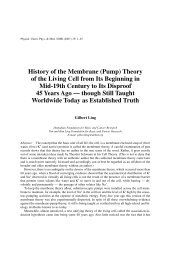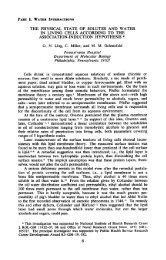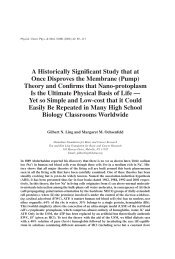Primary Thermosensory Events in Cells - Springer
Primary Thermosensory Events in Cells - Springer
Primary Thermosensory Events in Cells - Springer
You also want an ePaper? Increase the reach of your titles
YUMPU automatically turns print PDFs into web optimized ePapers that Google loves.
25 <strong>Primary</strong> <strong>Thermosensory</strong> <strong>Events</strong> <strong>in</strong> <strong>Cells</strong> 455<br />
of membrane-lipid fatty acids through express<strong>in</strong>g acyl-lipid desaturases [17–19].<br />
Lipid unsaturation would then restore membrane fluidity at the lower temperature.<br />
In B. subtilis, this lipid modification is <strong>in</strong>itiated through the activity of a so-called<br />
“two-component regulatory system” consist<strong>in</strong>g of the DesK and DesR prote<strong>in</strong>s [17].<br />
Prokaryotic two-component regulatory systems usually consist of prote<strong>in</strong> pairs: a<br />
sensor k<strong>in</strong>ase and a regulatory prote<strong>in</strong> [20].<br />
It appears that it is a comb<strong>in</strong>ation of membrane physical state and prote<strong>in</strong> conformation<br />
that is able to sense temperature and even to translate this sens<strong>in</strong>g event <strong>in</strong>to<br />
proper gene expression. However, sens<strong>in</strong>g of temperature through direct alteration<br />
<strong>in</strong> nucleic acid conformation might be more efficient temperature-mediated mechanism<br />
of gene expression.<br />
25.3 RNA and DNA Thermotropic Reactions<br />
Theoretically, RNA molecules have a strong potential as temperature sensors, <strong>in</strong> that<br />
they can form pronounced secondary and tertiary structures [21], and through their<br />
ability to form <strong>in</strong>termolecular RNA: RNA hybrids [22]. Both of these processes<br />
greatly depend on the formation of complementary base pair<strong>in</strong>g, and consequently<br />
one would anticipate these to be dependent on environmental temperature. Indeed,<br />
messenger RNAs, apart from carry<strong>in</strong>g their cod<strong>in</strong>g <strong>in</strong>formation for prote<strong>in</strong> generation<br />
are also rapidly emerg<strong>in</strong>g as regulators of expression of the encoded message.<br />
With unique chemical and structural properties, sensory RNAs perform vital regulatory<br />
roles <strong>in</strong> gene expression by detect<strong>in</strong>g changes <strong>in</strong> the cellular environment either<br />
alone or through <strong>in</strong>teractions with small ligands [23, 24] and prote<strong>in</strong>s [25, 26].<br />
Regulatory RNA elements, “riboswitches”, have been reported recently, respond<strong>in</strong>g<br />
to <strong>in</strong>tracellular signals by conformational changes. Riboswitches are conceptually<br />
divided <strong>in</strong>to two parts: an aptamer and an expression platform. The aptamer<br />
directly b<strong>in</strong>ds the small molecule, and the expression platform undergoes structural<br />
changes <strong>in</strong> response to the changes <strong>in</strong> the aptamer. The expression platform is what<br />
regulates gene expression. Riboswitches demonstrate that naturally occurr<strong>in</strong>g RNA<br />
can specifically response on versatile physical and chemical stimuli, a capability<br />
that many previously believed was the doma<strong>in</strong> of prote<strong>in</strong>s or artificially constructed<br />
RNAs [27].<br />
RNA thermometers operate at the post-transcriptional level to sense selectively<br />
the temperature and transduce a signal to the translation mach<strong>in</strong>ery via a conformational<br />
change. They have usually a highly structured 5 ′ -end that shields the<br />
ribosome b<strong>in</strong>d<strong>in</strong>g site at physiological temperatures [28–31]. Changes <strong>in</strong> temperature<br />
are manifested by the liberation of the Sh<strong>in</strong>e–Dalgarno (SD) sequence, thereby<br />
facilitat<strong>in</strong>g ribosome b<strong>in</strong>d<strong>in</strong>g and translation <strong>in</strong>itiation.<br />
It is known that both <strong>in</strong> prokaryotic and eukaryotic cells the geometry and tension<br />
of DNA is highly dynamic and corresponds to its functional activity. In the<br />
bacterial cell, chromosome and plasmid DNAs are conta<strong>in</strong>ed <strong>in</strong> a “twisted” superhelical<br />
conformation [32, 33], where the degree of supercoil<strong>in</strong>g varies <strong>in</strong> response to







